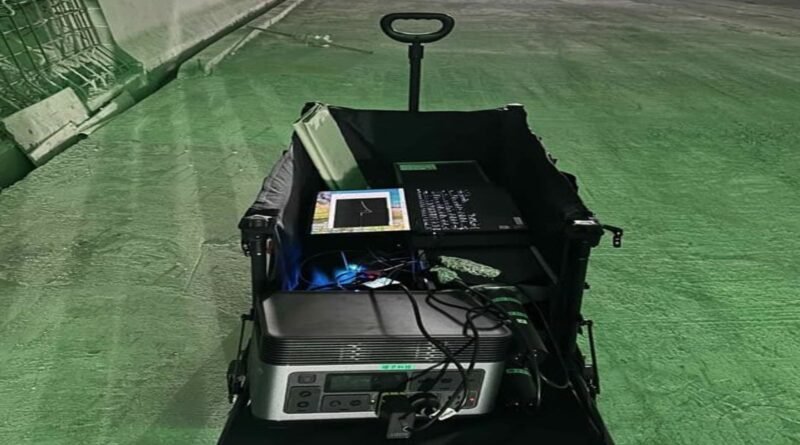Monitoring Shanghai’s Immersed Tunnels Using Cosmic Particles
Immersed tunnels are special structures that let people travel safely beneath rivers and other bodies of water. Tunnel segments are lowered underwater and connected, with the first such tunnel built as early as 1893. Today, there are over 200 of these tunnels worldwide. Although highly effective, these tunnels constantly face geotechnical challenges—sediment accumulation, groundwater fluctuations, and tidal influences—that can threaten their stability.
In Shanghai, the safety of immersed tunnels is particularly important. The Huangpu River, a tributary of the Yangtze, is vital for the city’s development, and its dynamics shape tunnel stability. Tidal cycles and inflows from the Taihu basin cause constant sediment changes, which can lead to settling and impact the tunnel’s structure. Monitoring and maintaining the stability of these tunnels, therefore, requires modern, smart technologies that operate quietly and safely, without interrupting traffic or endangering infrastructure.
Monitoring these structures isn’t easy. Traditional methods like drilling boreholes or sending sonar probes can be slow, invasive, or even risky, often requiring costly tunnel closures. Now, scientists are turning to innovative, non-invasive approaches that keep these tunnels safe without disturbing the flow of urban life.
All of this was explained by Chinese scientists, with Kim Siang Khaw, as the corresponding author, in a new study titled ‘Towards Non-Invasive Sediment Monitoring Using Muography: A Pilot Run at the Shanghai Outer Ring Tunnel.’ Kim Siang Khaw is an Assistant Professor at the Sung-Dao Lee Institute and School of Physics and Astronomy, Shanghai Jiao Tong University, Shanghai.
Yet this was only the start, since the study went on to explore muons.
The role of cosmic particles called muons
Muography, a method that uses cosmic particles called muons, can monitor sediment and tidal effects in underwater tunnels. Muons are created in the atmosphere when cosmic rays from space collide with air molecules, producing secondary particles that reach Earth at high speed. Due to their physical properties, muons can pass through dense materials such as sediment, water, and concrete.
To put this into practice, scientists placed a portable muon detector in Shanghai’s Outer Ring Tunnel beneath the Huangpu River. This allowed them to track changes in muon flux and compare them with water levels, enabling the analysis of tidal effects and the thickness of sediment and concrete layers above the tunnel. Computer simulations confirmed that muography accurately detects changes in sediment and water, demonstrating that it is a reliable method for real-time, long-term monitoring of underwater tunnels without the need for invasive measurements or damage to infrastructure.
The study presents an early attempt to use muography as a robust method for monitoring sediment thickness and analyzing tidal influences in the Shanghai Outer Ring Tunnel. By combining spatial scanning with fixed-site muon flux measurements, it demonstrates that the method is reliable in detecting variations in overburden in complex underground conditions.
This published paper marks a significant milestone
How did you come up with this idea? Considering the numerous weather-related disasters, such as floods, how could this research help in the future? What would you like to see more of in this area?
Kim Siang Khaw: This project started from a collaborative discussion between our institute (Tsung-Dao Lee Institute) and the Shanghai Urban Planning and Natural Resources Bureau. During these talks, the Bureau emphasized the practical challenges of monitoring sediment buildup around critical infrastructure, such as the Shanghai Outer Ring Tunnel, without causing disruptive and costly shutdowns. This real-world issue directly motivated our research. We formed a dedicated, cross-disciplinary team to explore solutions, and this published paper marks a significant milestone from those initial studies, showing the potential of a concept developed at the intersection of basic science and urban management needs. In principle, this approach can be used to provide early warnings for disasters like tsunamis, landslides, and so on. A sudden change in water or soil volume can be quickly detected on the muon flux monitor. We are collaborating with geologists in Shanghai to explore additional applications of Muography.
How important are factors such as humidity, location, or temperature? Do they play a role in detection?
Kim Siang Khaw: The muon flux can be influenced by conditions in the upper atmosphere, such as air pressure and temperature. We can account for this variation in muon flux by installing another detector at sea level as a reference measurement. In terms of the detector operation, our detectors are not significantly affected by humidity as long as the electronic components are enclosed in a protective case. The device temperature can also be stabilized if needed; however, in most underwater tunnels, temperatures remain relatively stable. Location-wise, the detector can be placed anywhere, even 1000 meters underground (with less flux, of course).
It is essential to develop advanced, non-invasive systems to monitor the integrity of these underground structures and ensure safety
Why did you choose Shanghai, and what does the city specifically offer for this type of research? Are there other locations where you would like to conduct this research?
Kim Siang Khaw: Muography techniques have been widely used in archaeology and volcanic studies, but their use in urban environments remains limited. In Shanghai, a city with a dense population, underground spaces are rapidly growing and being utilized more often. Therefore, it is essential to develop advanced, non-invasive systems to monitor the integrity of these underground structures and ensure safety. We plan to apply muography techniques in Shanghai for other purposes as well, such as detecting deep underground karst formations and supporting civil engineering projects. Once feasibility tests are completed, these methods can be adapted for use in other cities across China or globally.
Muons were discovered by Carl D. Anderson and Seth Neddermeyer at Caltech in 1936. Today, these cosmic particles are harnessed in muography to monitor sediment accumulation and structural changes in Shanghai’s immersed tunnels. While this study represents a preliminary application, it demonstrates the potential of non-invasive, real-time monitoring to improve tunnel safety by offering early warnings and guiding maintenance.
Image: Khaw et al. – Muon detection system measuring muon flux during a spatial scan of the Shanghai Outer Ring Tunnel.


